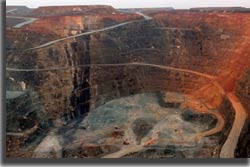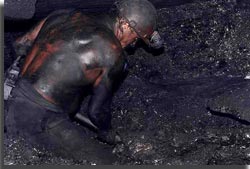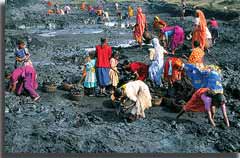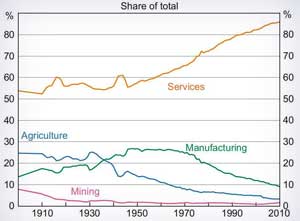| Size of the Industry | 12745 million tonnes of iron ore, 2,525 million tonnes of bauxite, 233 million tonnes of magnesite, 76446 million tonnes of limestone, 70 million tonnes of barites, 167 million tonnes of lead & zinc ore, 176 million tonnes of manganese ore and 90 million tonnes of chromite. |
| Geographical distribution | Major cities of India like Bombay, Karnataka, New Delhi, Hyderabad, Kerala, and Banglore. |
| Output per annum | Rs. 568070 Millions |
| Market capitalization | 10% to 11%. of share |

Due to all these efforts of the Indian Mining Industry several foreign companies have begun investing in India, with the majority usually coming from Canada and the USA, Australia, UK and South Africa. Mostly the demand is for base metals, diamond, mineral sands and gold sectors.
To assist in the development of the country's mineral resources India has set up several governmental agencies like the The Geological Survey of India (GSI) which is the principal agency responsible for the assessment of geological and regional mineral resources of the country established in 1851 and is one of India's oldest investigative agencies in the field of earth sciences. Its areas of operation help the scientific surveys and research, for locating mineral resources. GSI office operates through six regional offices and four specialized wings - marine, coal geophysics, airborne surveys and training.
Other one is The Indian Bureau of Mines (IBM) which is the principal government agency responsible for compiling exploration data and mineral maps and for providing access to the latest information in respect of mineral resources in the country. IBM has both regulatory as well as service functions.


India has the largest reserves of barites in the world. Total value of mineral production of Indian Mining Industry is Rs. 568070 million in 2000-2001. The metallic production constitutes the iron-ore, chromite, copper-ore, zinc concentrates, manganese ore, gold, bauxite, lead concentrates. Amongst the non-metallic minerals, 90% of the aggregate value is contributed by the limestone, gypsum, barites, magnesite, dolomite, kaolin, apatite & steatite, phosphorite and fluorite.
There are two categories of Indian bituminous coals namely, coking and non-coking. Coal exploration in India today is largely being carried out by conventional methods of systematic geological mapping followed by drilling, core drilling playing a dominant role. Today due to the modern exploration techniques like photo-geology, remote sensing, and non-coring drilling, geophysical surveys etc. are used for detailed and precise exploration.
- NCDC - National Coal Development Corporation of India
- NMDC - National Mineral Development Corporation of India
- BALCO - Bharat Aluminium Company
- PPCL - Pyrites, Phosphates and Chemicals Ltd.
- HZL - Hindustan Zinc Ltd.
- NLCL - Neyveli Lignite Corporation Limited
- HCL - Hindustan Copper Ltd.
- BGML - Bharat Gold Mines ltd.
- SAIL - Steel Authority of India Limited (formerly Hindustan Steel Ltd.)
This sector has opportunities knocking at the door for skilled professionals who would be very much familiar with the Mining patterns of the Country. Due to the amendments in the MM (R&D) Act & Mines and Minerals (Regulation and Development) Act in 1996, opening up of private players by the government has taken various steps to encourage the investments in the sector. With the recent formation of the New National Mining Policy in place, the Ministry of Mines plans to attract investments of Rs 1,00,000 crore in the mining sector.
|  |
- India today has the capacity to produce 86 minerals which include 4 fuels, 10 metallic, 46 non-metallic, 3 atomic and 23 minor minerals & si the leading producer of mica blocks and splitting.
- Indian Mining Industry ranks 2nd in barites, chromite and talc/steatite/pyrophillite;
- India ranks 3rd in coal & lignite and bauxite;
- India ranks 4th in iron ore and kyanite/sillimanite;
- India ranks 5th in manganese ore and steel (crude);
- India ranks 7th in zinc; and
- Ranks 8th in aluminium
-
New export tax on Iron ore retarding India-China trade
The powerful economies in world around Asia, India and China are trade partners in some of the most vital metals, minerals and other such resources are very much needed for the economic growth.
The financial year 1999-2000 saw 60% increase in the exports of iron ore to China by India. China's top imports include Mineral fuel and oil, Iron & steel, Ore, slag and ash & Copper and related articles. The major portion of the India's import to China constitutes primary products like ores. Indian exports to China the top export items that account for the maximum percentage of transactions. The following figures of 2003-04 reveal this:
- Top 3 export items accounted for 58.7% of total exports
- Top 5 export items accounted for 70.1% of total exports
- Top 10 export items accounted for 83.9% of total exports
-
FDI In Indian Mining And Minerals Industry
Ministry of Mining formulated the National Mining Policy by raising the level of domestic and foreign direct investments in the sector to Rs 1,00,000 crore. This new policy of Indian Mining Industry aims at promoting growth of the Industry.The Industry plans to create employment for about 5 lakh skilled and unskilled labour force in the industry which currently employs 1.1 million people
-
Indian Companies Going Abroad
India today has been able set up companies by going abroad and acquiring other firms with similar profiles and is also investing in their assets overseas. Indian Mining Industry is making its presence felt across the globe, for instance from an offshore oil field in Australia to a steel company in Thailand. Amongst the Indian private players, Reliance Energy Limited (REL) owned by Anil Ambani is exploring the options of getting the coal mines in Indonesia and Australia. These efforts usually meet the requirements of coal as raw material for its upcoming projects in Uttar Pradesh and Maharashtra. REL's total investment would be of around $ 500 million if this deal under consideration gets finalized.
 Recent Press Release
Recent Press Release
 INDIAN mining INDUSTRY AT A Glance IN 2021 - 2022
INDIAN mining INDUSTRY AT A Glance IN 2021 - 2022
 INDIAN mining INDUSTRY AT A Glance IN 2020 - 2021
INDIAN mining INDUSTRY AT A Glance IN 2020 - 2021
 INDIAN mining INDUSTRY AT A Glance IN 2019 - 2020
INDIAN mining INDUSTRY AT A Glance IN 2019 - 2020
 INDIAN mining INDUSTRY AT A Glance IN 2018 - 2019
INDIAN mining INDUSTRY AT A Glance IN 2018 - 2019
 INDIAN mining INDUSTRY AT A Glance IN 2017 - 2018
INDIAN mining INDUSTRY AT A Glance IN 2017 - 2018
 INDIAN mining INDUSTRY AT A Glance IN 2016 - 2017
INDIAN mining INDUSTRY AT A Glance IN 2016 - 2017
 INDIAN mining INDUSTRY AT A Glance IN 2015 - 2016
INDIAN mining INDUSTRY AT A Glance IN 2015 - 2016
 INDIAN mining INDUSTRY AT A Glance IN 2014 - 2015
INDIAN mining INDUSTRY AT A Glance IN 2014 - 2015
 INDIAN mining INDUSTRY AT A Glance IN 2013 - 2014
INDIAN mining INDUSTRY AT A Glance IN 2013 - 2014
 INDIAN mining INDUSTRY AT A Glance IN 2012 - 2013
INDIAN mining INDUSTRY AT A Glance IN 2012 - 2013
 INDIAN mining INDUSTRY AT A Glance IN 2011 - 2012
INDIAN mining INDUSTRY AT A Glance IN 2011 - 2012
 |
INDIAN INDUSTRIES |



 INDIAN MINING INDUSTRY
INDIAN MINING INDUSTRY